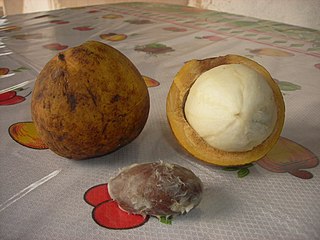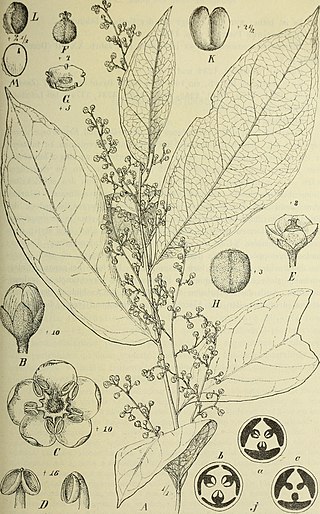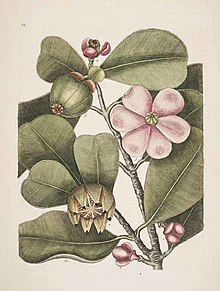
The Malpighiales comprise one of the largest orders of flowering plants, containing about 36 families and more than 16,000 species, about 7.8% of the eudicots. The order is very diverse, containing plants as different as the willow, violet, poinsettia, manchineel, rafflesia and coca plant, and are hard to recognize except with molecular phylogenetic evidence. It is not part of any of the classification systems based only on plant morphology. Molecular clock calculations estimate the origin of stem group Malpighiales at around 100 million years ago (Mya) and the origin of crown group Malpighiales at about 90 Mya.

Violaceae is a family of flowering plants established in 1802, consisting of about 1000 species in about 25 genera. It takes its name from the genus Viola, the violets and pansies.

Hypericaceae is a plant family in the order Malpighiales, comprising six to nine genera and up to 700 species, and commonly known as the St. John's wort family. Members are found throughout the world apart from extremely cold or dry habitats. Hypericum and Triadenum occur in temperate regions but other genera are mostly tropical.

Scilloideae is a subfamily of bulbous plants within the family Asparagaceae. Scilloideae is sometimes treated as a separate family Hyacinthaceae, named after the genus Hyacinthus. Scilloideae or Hyacinthaceae include many familiar garden plants such as Hyacinthus (hyacinths), Hyacinthoides (bluebells), Muscari and Scilla and Puschkinia. Some are important as cut flowers.

Haemodoraceae is a family of perennial herbaceous flowering plants with 14 genera and 102 known species. It is sometimes known as the "bloodroot family". Primarily a Southern Hemisphere family, they are found in South Africa, Australia and New Guinea, and in the Americas. Perhaps the best known are the widely cultivated and unusual kangaroo paws from Australia, of the two closely related genera Anigozanthos and Macropidia.

Platonia insignis, the sole species of the genus Platonia, is a tree of the family Clusiaceae native to South America in the humid forests of Brazil, Paraguay, parts of Colombia and northeast to Guyana; especially in Amazon Rainforest. Common names include bacuri, maniballi, naranjillo and bacurizeiro.

Ochnaceae is a family of flowering plants in the order Malpighiales. In the APG III system of classification of flowering plants, Ochnaceae is defined broadly, to include about 550 species, and encompasses what some taxonomists have treated as the separate families Medusagynaceae and Quiinaceae. In a phylogenetic study that was published in 2014, Ochnaceae was recognized in the broad sense, but two works published after APG III have accepted the small families Medusagynaceae and Quiinaceae. These have not been accepted by APG IV (2016).

The family Pandaceae consists of three genera that were formerly recognized in the Euphorbiaceae. Those are:

Podostemaceae, a family in the order Malpighiales, comprise about 50 genera and c. 300 species of more or less thalloid aquatic herbs.

Montrouziera is a genus of shrubs to large trees in the family Clusiaceae, endemic to New Caledonia. As usual in the Clusiaceae, species of this genus are known to contain xanthonoids. Montrouziera is related to the South American genus Platonia. Locally known as "houp", this genus was named after Xavier Montrouzier.

Moronobea is a plant genus of the family Clusiaceae. They are glabrous medium to large trees with yellow latex. The genus comprises 7 species, native to South America, 5 of which are in Venezuela. It is related to Platonia and Montrouziera.
Neotatea is a plant genus in the family Calophyllaceae. It is found in northwestern South America, primarily southern Colombia and Venezuela. There are four species currently recognized in the genus.

Malpighiaceae is a family of flowering plants in the order Malpighiales. It comprises about 73 genera and 1315 species, all of which are native to the tropics and subtropics. About 80% of the genera and 90% of the species occur in the New World and the rest in the Old World.

Bonnetiaceae is a family of flowering plants, consisting of 4 genera and 41 species. The family is Neotropical, with the exception of the genus Ploiarium, which is found in Malesia. It is sister to the family Clusiaceae.

Chrysobalanaceae is a family of flowering plants, consisting of trees and shrubs in 27 genera and about 700 species of pantropical distribution with a centre of diversity in the Amazon. Some of the species contain silica in their bodies for rigidity and so the mesophyll often has sclerenchymatous idioblasts. The widespread species Chrysobalanus icaco produces a plum-like fruit and the plant is commonly known as the coco plum.

Picrodendraceae is a family of flowering plants, consisting of 80 species in 24 genera. These are subtropical to tropical and found in New Guinea, Australia, New Caledonia, Madagascar, continental Africa, and tropical America. Its closest relatives are Phyllanthaceae.

Calophyllaceae is a family of flowering plants in the order Malpighiales and is recognized by the APG III system of classification. Most of the 14 genera and 475 species included in this family were previously recognized in the tribe Calophylleae of the family Clusiaceae. The Angiosperm Phylogeny Group determined that splitting this clade of genera off into their own family was necessary.

Centroplacaceae is a family of flowering plants in the order Malpighiales and is recognized by the APG III system of classification. The family comprises two genera: Bhesa, which was formerly recognized in the Celastraceae, and Centroplacus, which was formerly recognized in the Euphorbiaceae, together comprising six species. The Angiosperm Phylogeny Group determined that based on previous phylogenetic analysis, these two genera formed an isolated clade and recognition of the family was "reasonable."

Peraceae Klotzsch is a family of flowering plants in the eudicot order Malpighiales. The family was segregated from the Euphorbiaceae by Johann Friedrich Klotzsch in 1859, and its uniqueness was affirmed by the Royal Botanic Gardens, Kew's Euphorbiaceae expert, Airy Shaw.






















